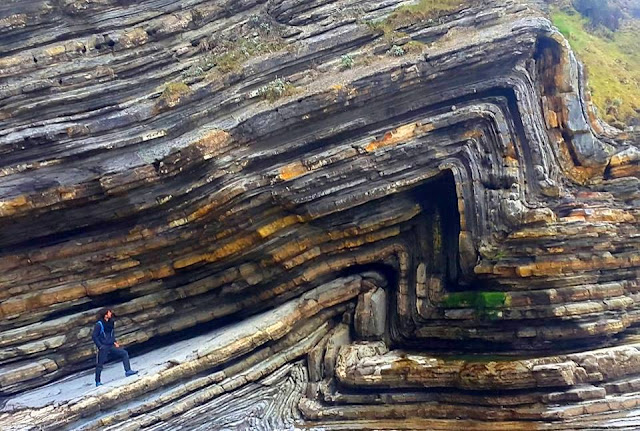Photo credit Thibault Cavailhes, via GeologyIn, via Reddit.
New word for me:
Flysch is a sequence of sedimentary rock layers that progress from deep-water and turbidity flow deposits to shallow-water shales and sandstones. It is deposited when a deep basin forms rapidly on the continental side of a mountain building episode. Examples are found near the North American Cordillera, the Alps, the Pyrenees and the Carpathians.
The name comes from the German word fliessen, which means to flow, because Studer thought flysch was deposited by rivers. The insight that flysch is actually a deep marine sediment typical for a particular plate tectonic setting came only much later.

Looks delicious!
ReplyDeleteSimilar, albeit less obvious to Bwa Maen in Wales(UK)
ReplyDeletehttps://www.google.com/url?sa=i&url=https%3A%2F%2Ftwitter.com%2Fbritgeosurvey%2Fstatus%2F661539735874183168&psig=AOvVaw0vSd4ygQtN1M3WivcQ_WKZ&ust=1589546143090000&source=images&cd=vfe&ved=0CAIQjRxqFwoTCLj4mfuus-kCFQAAAAAdAAAAABBC
https://www.google.com/url?sa=i&url=https%3A%2F%2Fsewrigs.wordpress.com%2F2017%2F11%2F11%2Fexploration-of-the-area-near-craig-y-dinas%2F&psig=AOvVaw0vSd4ygQtN1M3WivcQ_WKZ&ust=1589546143090000&source=images&cd=vfe&ved=0CAIQjRxqFwoTCLj4mfuus-kCFQAAAAAdAAAAABBI
Let's hear it for Loughshinny, Co. Dublin:
ReplyDeletehttps://www.sandatlas.org/folds-at-loughshinny/
Some folks are calling "Flysch", fold will do for me.
What type of fold is this symmetrical or asymmetrical
ReplyDelete